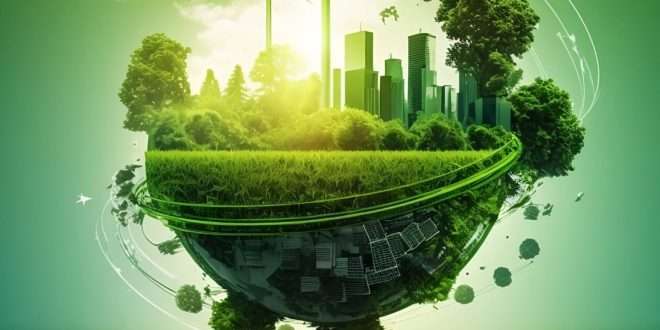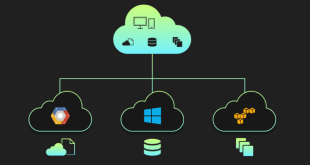In today’s digital age, where data and information reign supreme, cloud computing has become the backbone of numerous industries. However, the increasing energy demands and carbon footprint of traditional cloud infrastructure raise concerns about environmental sustainability. In this blog, we delve into the concept of “Green Clouds,” exploring innovative and sustainable infrastructure solutions that promise a greener tomorrow. Join us on this eco-friendly journey as we discover how cloud computing can play a pivotal role in mitigating environmental impact while still delivering top-notch services.
Understanding Cloud Computing and Its Environmental Impact
Cloud computing is a powerful technology that enables access to a vast array of resources and services through the internet. As more businesses and individuals adopt cloud services, the energy consumption of data centers supporting these services surges. Traditional data centers heavily reliant on non-renewable energy sources significantly contribute to carbon emissions. To create a sustainable future, it is essential to explore greener alternatives.
Cloud computing services | Key Points:
- Offer on-demand availability of resources
- Facilitate scalability and flexibility
- Drive cost efficiency for businesses
The Emergence of Green Clouds
The term “Green Clouds” refers to environmentally friendly cloud computing solutions that prioritize sustainability and energy efficiency. Various industry leaders have taken significant steps towards adopting green practices within their data centers. Key factors influencing the emergence of green clouds include:
Renewable Energy Integration | Key Points:
- Emphasis on using renewable energy sources
- Powering data centers with solar, wind, or hydroelectric energy
- Reduced carbon emissions and energy costs
Eco-Friendly Data Centers: The Foundation of Green Clouds
Eco-friendly data centers form the backbone of green clouds. These data centers employ innovative technologies and design principles to minimize energy consumption and environmental impact.
Key Features of Eco-Friendly Data Centers:
Energy-efficient Cooling Systems:
Implementing advanced cooling techniques, such as liquid cooling and hot/cold aisle containment.Utilizing outside air cooling in favorable climates to reduce the need for power-hungry air conditioning.
Server Virtualization:
Consolidating multiple virtual servers on a single physical server to optimize resource utilization and energy efficiency.
Efficient Hardware Selection:
Choosing energy-efficient hardware components, such as low-power processors and solid-state drives (SSDs).
Data Center Location:
Establishing data centers in regions with access to renewable energy sources.
Cloud Providers Leading the Green Revolution
Several major cloud providers have recognized the urgency of addressing environmental concerns and have undertaken impressive initiatives to build greener infrastructures.
Amazon Web Services (AWS) | Key Initiatives:
- Commitment to achieve 100% renewable energy usage
- Investment in wind and solar projects to power data centers
Microsoft Azure | Key Initiatives:
- Carbon-negative aspirations by 2030
- Utilizing AI to optimize data center cooling and energy usage
Google Cloud Platform (GCP) | Key Initiatives:
- Decade-long history of carbon neutrality
- Pioneering energy-efficient data center designs
The Role of Edge Computing in Green Clouds
Edge computing complements cloud computing by decentralizing data processing and reducing the need for long-distance data transfers. This approach significantly reduces energy consumption and enhances the overall efficiency of the cloud infrastructure.
Key Benefits of Edge Computing in Green Clouds:
- Reduced latency for time-sensitive applications
- Minimized data transfer, leading to lower energy consumption
- Enhanced reliability and security
Green Clouds in Action: Real-World Success Stories
Numerous organizations have embraced green clouds, leading the way towards a more sustainable future. Let’s explore some inspiring success stories:
Etsy’s Journey to Sustainability:
- Etsy, the online marketplace, achieved carbon neutrality by offsetting its carbon emissions through renewable energy projects.
- The company migrated its data centers to Google Cloud, which operates on 100% renewable energy.
Greenpeace and its Green Cloud Report:
- Greenpeace’s Cloud Clean-Up campaign encourages companies to prioritize renewable energy for cloud computing.
- Greenpeace’s Green Cloud Report assesses the sustainability efforts of major cloud providers.
Overcoming Challenges on the Path to Greener Clouds
Despite the remarkable progress in green cloud adoption, some challenges persist. Key challenges include:
Energy Storage | Key Points:
- Addressing the intermittency of renewable energy sources through efficient energy storage solutions.
- Advancements in battery technology and grid management to ensure consistent power supply.
The Future of Green Clouds: Looking Ahead
The future of green clouds appears promising, with innovations and global commitments to sustainability.
Anticipated Trends:
Continued Renewable Energy Adoption:
More cloud providers and businesses shifting to renewable energy sources.
Improved Energy Storage Solutions:
Advancements in energy storage technologies for enhanced reliability.
Eco-Friendly Hardware Advancements:
Ongoing development of energy-efficient server components.
Final Words
: Paving the Way for a Greener Tomorrow
Green clouds present a transformative opportunity for the tech industry to contribute positively to the environment. By embracing sustainable infrastructure solutions, cloud computing can lead the way towards a greener, more eco-conscious future. Together, we can harness the power of technology to drive positive change for generations to come.
Commonly Asked Questions
1. What is the main goal of green clouds?
- The primary objective of green clouds is to minimize the environmental impact of cloud computing by adopting sustainable infrastructure and renewable energy sources.
2. How do green clouds differ from traditional cloud solutions?
- Green clouds prioritize energy efficiency, renewable energy integration, and eco-friendly data center practices, while traditional clouds may rely on non-renewable energy and less efficient cooling methods.
3. Are all major cloud providers committed to green initiatives?
- Many major cloud providers have made substantial commitments to sustainability, investing in renewable energy projects and adopting energy-efficient practices.
4. How can businesses contribute to green cloud adoption?
- Businesses can opt for cloud service providers with robust sustainability initiatives and support the adoption of renewable energy for data centers.
5. What are the key benefits of edge computing in green clouds?
- Edge computing reduces energy consumption by processing data closer to the source, leading to lower latency, minimized data transfers, and enhanced overall efficiency.
 webfily
webfily



